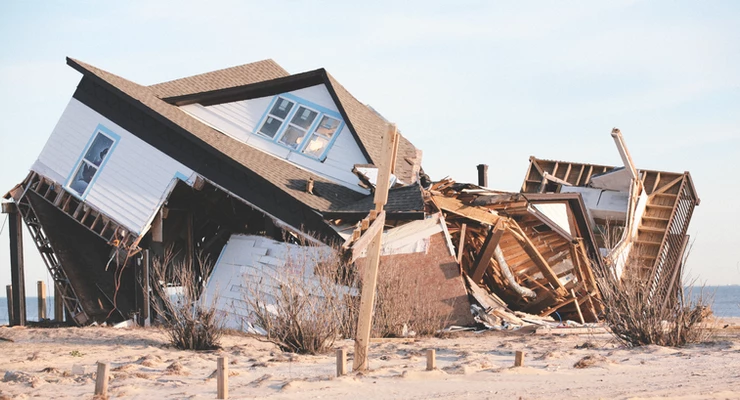Landlord insurance covers most common risks property investors face, but it doesn’t cover everything. This is why…
Landlord insurance is a wise investment for owners who lease their property. It generally provides protection for the main risks landlords face including:
- Tenant damage – accidental or malicious caused by tenants, their pets or guests.
- Building cover – if the property is damaged or destroyed as a result of an insured event such as theft, fire, flood, cyclone, earthquake or storm..
- Contents cover for the landlord’s belongings..
- Loss of rent – resulting from an event the insurer has agreed to cover..
- Legal liability – in case someone is injured or their property is damaged.
- Costs associated with taking legal action against a tenant..
But landlord insurance doesn’t cover every possible situation as the overload in risk would make insurance unaffordable. So, insurers need to strike a balance between providing cover for the most common eventualities, while keeping their level of risk at a manageable level.
Here are eight things not commonly covered – and why:
Run-of-the-mill expenses
In the same way the insurance you have for your home and contents doesn’t cover everyday out-of-pocket expenses, landlord insurance doesn’t cover the day-to-day costs associated with owning an investment property either. We don’t reimburse the cost of regular maintenance, such as a plumber’s bill for unblocking a sink or payment for a lawn mowing service. These routine expenses are part of owning a property and are costs landlords should expect to incur as part of managing their investment. Landlord insurance is designed to protect against unforeseen events, not planned expenses.
Tenant repairs
When it comes to repairs at the investment property by the tenant, their handiwork and DIY projects may be covered under accidental damage. However, it is not encouraged they conduct any repairs for risk of injury. Insurance may also cover the cost of repairs carried out by qualified tradies, however repairs by the landlord is generally not covered as they are not typically skilled in this area. Having unqualified people carry out repairs presents an increased risk of property damage or bodily injury, and it’s a risk insurers are usually not willing to cover. It is a condition in practically all building policies that the property must be adequately maintained and failure to do so can void the cover, so landlords and their agents should ensure repairs and maintenance are carried out by qualified/licensed/registered/appropriately insured professionals.
Wear and tear
Just as run-of-the-mill expenses are not covered, landlord insurance also doesn’t cover general wear and tear at the property. Again, reasonable wear is something a landlord should expect as part of the property being lived in – it’s not unforeseeable. Of course, if the damage is the result of an accident or a malicious act, then insurance may respond.
Mould
Responsibility for taking care of mould outbreaks at a rental can rest with the landlord or the tenant, depending on the cause. But regardless of the cause and who is responsible, costs associated with mould are not usually covered by landlord insurance. As mould growth is frequently unavoidable, and because it usually doesn’t cause any damage if it is taken care of quickly, insurance does not cover mould damage.
Building defects
Landlord insurance is designed to protect investors from the risks associated with renting out their property. Building defects are not a risk unique to investment properties; they are construction/design issues. In general, an architect or engineer is usually responsible for defects in the design of a project, while the builder is usually responsible for defects caused by a failure to construct according to design specifications. Depending on the age of the building, defects may be covered by insurance such as builder’s warranty. Otherwise it is a case of caveat emptor, ‘let the buyer beware’, and building insurance will rarely cover any defects. It’s a bit like a pre-existing condition with health, travel or life insurance – insurers won’t offer cover for something that’s already broken. Basically, insurers assume that the building was properly built and won’t take on the responsibility if it wasn’t.
Tenant contents
It’s a common misconception that a landlord’s insurance covers the personal possessions of their tenants. The landlord’s insurance covers the building and any contents at the property that are owned by the landlord (if they are related to the letting of the property) – but not those owned by the renters. In offering cover to a landlord, the insurer is accepting the risks associated with the landlord’s property, not that of other parties. Except in cases where the tenant’s loss is the result of negligence on the landlord’s behalf, any damage or loss of a tenant’s property is their responsibility. That’s why tenants need renters’ contents insurance.
Weather events
Don’t panic! We aren’t saying they don’t cover fire, flood, cyclone or storm. However, there may be an embargo on issuing insurance policies if an event is imminent or already taking place. Embargoes prevent people buying insurance when the risks are elevated or a disaster is approaching and then cancelling cover after the risk passes. If an insured risk is imminent, the probability of that risk occurring and therefore a claim being lodged is high, so embargoes take effect when events such as fires, floods and cyclones are impacting or considered likely to impact an area. Like any kind of insurance, landlord cover can’t be purchased after a loss has occurred. For example, you can’t take out car insurance to claim for an accident you’ve already had. Landlord insurers are also very unlikely to agree to extend cover to a person when it’s almost inevitable that a claim will need to be made – much like not being able to take out health insurance the day before you are scheduled to have elective surgery at a private hospital. Rest assured, if a landlord already has cover in place and needs to claim for an insured event, then they should be able to.
TIP:
Landlord insurance providers will not take on the risk if a landlord tries to take out a policy and claim for rent arears if the tenant is already in arrears at the time the policy is issued. If a tenant is in arrears to the point where notices could be served to remedy the arrears at the time the policy is taken out, and doesn’t get up to date, then liability for a loss of rent or damage claim will not usually be accepted by the insurance provider.
Market conditions
Like all investments, there are risks in property. Some of those risks stem from the property market itself, and these risks are not covered by landlord insurance. The risks are inherent in the act of investing and can’t be passed onto an insurer – it would make premiums cost prohibitive if insurers were to assume the market-driven risks or those associated with poor management. For example, a landlord generally can’t claim against their insurance if they are not able to find a tenant for their property. Or claim the difference in rents achieved, for example, if they used to get $400 per week and now get $350 per week, the $50 per week loss can’t be claimed. If a landlord suffers loss of rent due to an insured eventuality, like default or denial of access, then a claim can often be made to recoup those losses.
At Active Agents, we have struck a special deal with EBM Rent Cover for which you can obtain coverage not commonly found in standard policies.To find out more, click here.
*While we have taken care to ensure the information above is true and correct at the time of publication, changes in circumstances and legislation after the displayed date may impact the accuracy of this article. This article has been provided by EBM Rent Cover and edited for our use.

